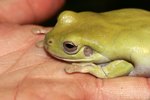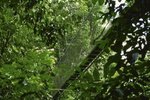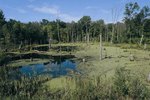
Humid tropical rain forests offer the moisture that tree frogs need to survive. The world is home to more than 700 species of tree frogs, but you’ll find the greatest variety in the Amazon River area of South America. Trees provide safety from roaming predators and offer plenty of access to the flies, beetles, moths and crickets that tree frogs eat.
About Tree Frogs
Although they’re called tree frogs, they don't all live in trees. The name really refers to the frogs’ ability to climb trees, thanks to their long legs, toe pads and claw-shaped bones at the end of their toes. A claw-shaped bone at the end of its toes helps the tree frog grip tree trunks and branches. Toe pads also help the frog scale trees. Body color plays an important part in the tree frog’s survival because it allows the frog to blend in with its surroundings or scare away predators.
Habitat
Making a home on the ground can be dangerous for frogs, but some types of tree frogs do spend a significant amount of time in ponds, lakes or other water sources. The more time a frog spends on the ground, the longer it is exposed to predators. Tree frogs that spend most of their lives in trees still risk being eaten by predators, but only face threats from predators that can climb or fly. Frequent rain and the general humid environment of the rain forest means that tree frogs can get all the water they need without leaving the safety of the trees.
Tree Frog Types
All the red-eyed tree frog has to do is open its eyes to frighten predators. One look at the frog’s bulging eyes and blue and yellow body makes most predators reconsider taking a bite of the frog, which gives it time to escape. Australia’s green tree frog is one tree frog that doesn’t spend all of its time in trees and will even sneak into houses. Indoors, it looks for water sources, such as water tanks or bathrooms. Brightly colored poison dart frogs kill frogs with their deadly venom. The National Geographic website reports that the frogs might pick up the poisons when they kill ants, beetles and termites and notes that poison dart frogs raised in captivity with no access to native insects don’t produce venom.
Threats
A variety of mammals, birds and reptiles eat tree frogs. Fish also eat them if they spend time in the water. While other tree frogs face threats from multiple predators, poison dart frogs only have to worry about the Leimadophis epinephelus, a snake that isn’t affected by the poison dart frog’s venom. Because tree frogs breathe through their skin and their lungs, they can become sick if exposed to pollutants and toxins in the air and environment. Destruction of the rain forest destroys tree frog habitats, which leads to a decline in the tree frog population in that area.
References
Photo Credits
-
Jupiterimages/liquidlibrary/Getty Images
Writer Bio
Working at a humane society allowed Jill Leviticus to combine her business management experience with her love of animals. Leviticus has a journalism degree from Lock Haven University, has written for Nonprofit Management Report, Volunteer Management Report and Healthy Pet, and has worked in the healthcare field.




